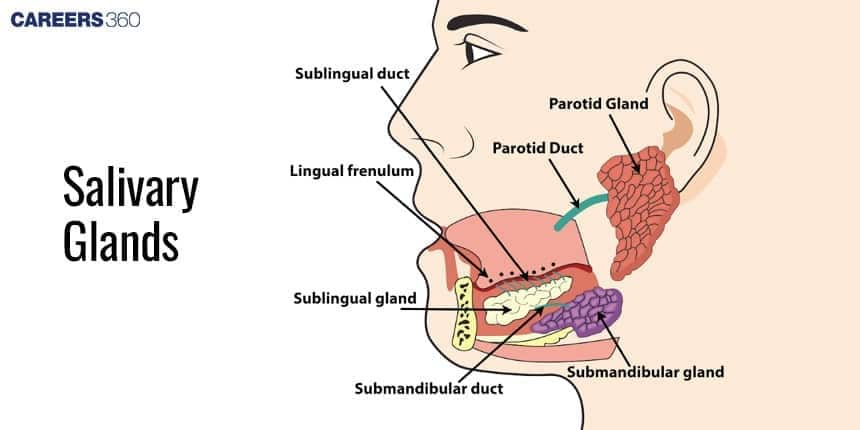Salivary Glands: Definition, Function, Diagram, Examples
Salivary glands are exocrine glands that secrete saliva into the oral cavity, initiating digestion and maintaining oral health. Saliva contains enzymes like amylase, mucus, electrolytes, and antibacterial substances essential for swallowing, digestion, and protection of teeth and gums. This guide explains the types, anatomy, histology, functions, composition, and NEET-focused concepts of salivary glands.
This Story also Contains
- What Are Salivary Glands?
- Types of Salivary Glands
- Anatomy of Salivary Glands
- Functions of Salivary Glands
- Composition of Saliva
- Salivary Glands NEET MCQs (With Answers & Explanations)
- Recommended Video on Salivary Glands

What Are Salivary Glands?
Salivary glands are vital in the human body, producing and releasing saliva into the oral cavity. It is a clear, slightly watery liquid that contains enzymes such as amylase, initiators of starch digestion. It lubricates food for easy swallowing and has antibacterial properties for the sake of teeth and gum health.
Types of Salivary Glands
The two types of salivary glands are:
Minor Salivary Glands
Major salivary glands are:
Parotid Glands
Site: Positioned in front of the ears, extending to the cheeks adjacent to the ears.
Histology: Serous acini-producing watery saliva is found.
Function: Principally secreting saliva rich in enzymes that initiate digestion.
Submandibular Glands
Position: Under the lower jawbone.
Structure: These glands are serous and mucous acini, this gland produces mixed saliva.
Function: The saliva this gland produces contains enzymes: for lubrication and the initiation of digestion.
Sublingual Glands
Position: Under the tongue.
Structure: Principally composed of mucous acini.
Function: Products are predominantly mucous, allowing lubrication and protection of the oral mucosa.
Minor Salivary Glands
Location: Widely distributed throughout the cavity of the mouth, in the lips, cheeks, and palate.
Types: Chiefly mucous glands.
Functions: Assist in continuous secretion of saliva that moistens the mouth to ease speech and swallowing.

Anatomy of Salivary Glands
The anatomy of salivary glands is discussed below:
Secretory Units (Acini)
Functional units of salivary glands
Enveloped by myoepithelium, which contracts to squeeze out the saliva.
Duct System
Ducts, namely, intercalated, striated, and excretory.
Carry the saliva from the acini into the oral cavity.
Cell Types
Serous Cells: Secrete watery saliva rich in enzymes.
Mucous Cells: Secrete mucus, which contributes to the lubricating action of saliva.
Myoepithelial Cells: Found surrounding acini and ducts, they squeeze out saliva.
Functions of Salivary Glands
The functions of salivary glands include:
Saliva Production
Continuously secreted to keep the mouth moist and to help in speech and swallowing.
Enzymatic Digestion
Starches are broken down into simple sugars in the presence of amylase.
Lubrication and Oral Hygiene
It moistens food for easy swallowing and prevents drying of the oral tissues.
Antibacterial Action
The combination of the enzymes and proteins in saliva inhibits bacterial overgrowth in the mouth, ensuring oral health.
Digestive Role
It initiates the digestion of carbohydrates and lipids and aids digestion.
Composition of Saliva
Saliva is composed of:
Water: Major part of saliva, providing a clear-fluid medium for various enzymes and other constituents.
Electrolytes: Electrolytes include the sodium, potassium, chloride, and bicarbonate ions. They maintain a pH balance.
Mucus: Lubricates the oral mucosa and protects it. Enzymes include amylase, lipase, and lysozyme which participate in digestion and antibacterial activity.
Antibacterial Compounds: Immunoglobulins and lysozyme play an essential role in preventing various infections of the oral cavity.
Salivary Glands NEET MCQs (With Answers & Explanations)
Important questions asked in NEET from this topic are:
Types of salivary glands
Role of salivary glands
Practice Questions for NEET
Q1. Which of the following is a digestive gland associated with the alimentary canal?
Liver
Pancreas
Salivary Gland
All of the above
Correct answer: 4) All of the above
Explanation:
The digestive system comprises salivary glands, the liver, and the pancreas, which all secrete essential substances for digestion. The salivary glands will secrete saliva containing salivary amylase that breaks starch into sugar. The liver secretes bile juice, which is used in the emulsification of fats. The gland from the pancreas will release pancreatic juice, which will contain trypsinogen and amylase that will digest proteins and carbohydrates. All these glands, along with their enzymes, are essential in the digestive process.
Hence, the correct answer is option 4)All of the above.
Q2. The pH of saliva is maintained at
6.85 - 7.4
5.0 - 6.0
3.0 - 4.5
4.0 - 6.1
Correct answer: 1) 6.85 - 7.4
Explanation:
Bicarbonate and phosphate ions are present in the saliva and function as chemical buffers, maintaining saliva at a pH between 6.85 and 7.4.
Hence, the correct answer is option 1) 6.85 - 7.4.
Q3. The parotid glands bear a duct called
Wharton’s duct
Rivinus duct
Stenson’s duct
Salivary duct
Correct answer: 3) Stenson’s duct
Explanation:
The parotid gland secretes saliva into the mouth through the parotid duct or Stenson’s duct, which is located near the second upper molar tooth. The parotid gland, the largest of the salivary glands, secretes serous saliva rich in enzymes, aiding in the initial digestion of starches and lubricating food for swallowing. Saliva is delivered into the mouth through the parotid duct, also known as Stenson’s duct, which opens near the second upper molar tooth on the buccal mucosa. The gland is located anterior to the ear and extends inferiorly to the mandibular angle. It is innervated by the glossopharyngeal nerve (cranial nerve IX) and plays a role in maintaining oral health by producing antibacterial enzymes.
Hence, the correct answer is option 3) Stenson’s duct.
Also Read:
Recommended Video on Salivary Glands
Frequently Asked Questions (FAQs)
Neural control - Sympathetic and parasympathetic nervous systems, hormonal influences.
Salivary glands produce saliva that helps in digestion, hygiene of the mouth, lubrication, and antibacterial activity.
There are three major salivary glands: parotid, submandibular, and sublingual, with many minor salivary glands situated throughout the mouth.
Saliva is chiefly composed of water, electrolytes, mucus, enzymes like amylase, and antibacterial compounds.
The common disorders are xerostomia or dry mouth, sialolithiasis or salivary stones, sialadenitis or inflammation, and tumours.